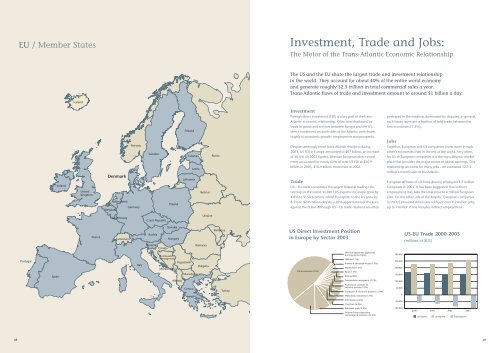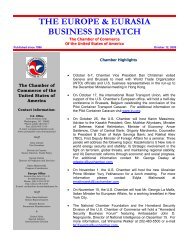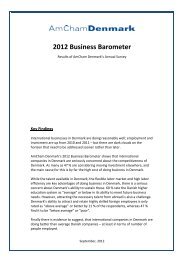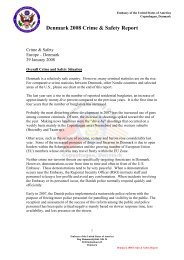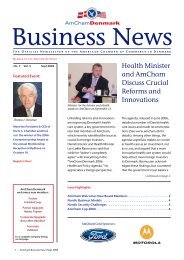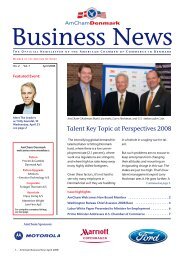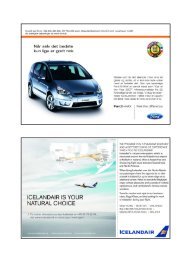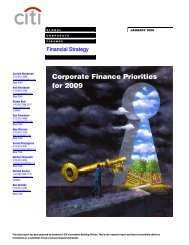omslag med 8mm ryg04#1 - American Chamber of Commerce in ...
omslag med 8mm ryg04#1 - American Chamber of Commerce in ...
omslag med 8mm ryg04#1 - American Chamber of Commerce in ...
Create successful ePaper yourself
Turn your PDF publications into a flip-book with our unique Google optimized e-Paper software.
48<br />
EU / Member States<br />
Portugal<br />
Spa<strong>in</strong><br />
Ireland<br />
Iceland<br />
United<br />
K<strong>in</strong>gdom<br />
France<br />
Denmark<br />
Belgium<br />
Netherlands<br />
Luxembourg<br />
Switzerland<br />
Norway<br />
Germany<br />
Italy<br />
Sweden<br />
Czech Republic<br />
Austria<br />
Slovenia<br />
Croatia<br />
Poland<br />
Slovakia<br />
Hungary<br />
Bosnia and<br />
Herzegov<strong>in</strong>a<br />
Montenegro<br />
F<strong>in</strong>land<br />
Yogoslavia<br />
Albania<br />
Estonia<br />
Lithuania<br />
Macedonia<br />
Greece<br />
Latvia<br />
Belarus<br />
Romania<br />
Ukra<strong>in</strong>e<br />
Bulgaria<br />
Russia<br />
Moldova<br />
Turkey<br />
Investment, Trade and Jobs:<br />
The Motor <strong>of</strong> the Trans-Atlantic Economic Relationship<br />
The US and the EU share the largest trade and <strong>in</strong>vestment relationship<br />
<strong>in</strong> the world. They account for about 40% <strong>of</strong> the entire world economy<br />
and generate roughly $2.5 trillion <strong>in</strong> total commercial sales a year.<br />
Trans-Atlantic flows <strong>of</strong> trade and <strong>in</strong>vestment amount to around $1 billion a day.<br />
Investment<br />
Foreign direct <strong>in</strong>vestment (FDI) is a key part <strong>of</strong> the trans-<br />
Atlantic economic relationship. Often overshadowed by<br />
trade <strong>in</strong> goods and services between Europe and the US,<br />
direct <strong>in</strong>vestment on both sides <strong>of</strong> the Atlantic contributes<br />
hugely to economic growth, employment and prosperity.<br />
Despite seem<strong>in</strong>gly tense trans-Atlantic relations dur<strong>in</strong>g<br />
2003, US FDI <strong>in</strong> Europe amounted to $87 billion, an <strong>in</strong>crease<br />
<strong>of</strong> 30.5% on 2002 figures. Likewise European direct <strong>in</strong>vestment<br />
accounted for nearly 65% <strong>of</strong> total US FDI at $36.9<br />
billion <strong>in</strong> 2003, $10.9 billion more than <strong>in</strong> 2002.<br />
Trade<br />
US – EU trade constitutes the largest bilateral trad<strong>in</strong>g relationship<br />
<strong>in</strong> the world. In 2003 US exports to Europe grew by<br />
4.8% to $150.6 billion, whilst EU exports to the US grew by<br />
8.5% to $245 billion despite a 20% appreciation <strong>of</strong> the euro<br />
aga<strong>in</strong>st the dollar. Although US – EU trade relations are <strong>of</strong>ten<br />
US Direct Investment Position<br />
<strong>in</strong> Europe by Sector 2003<br />
Other <strong>in</strong>dustries (47%)<br />
Electrical equipment, appliances,<br />
& components (0.6%)<br />
Utilities (1.1%)<br />
Primary & fabricated metals (1.2%)<br />
Mach<strong>in</strong>ery (1.3%)<br />
Food (1.3%)<br />
M<strong>in</strong><strong>in</strong>g (2%)<br />
Transportation equipment (2.1%)<br />
Pr<strong>of</strong>essional, scientific, &<br />
technical services (2.5%)<br />
Computers & electronic products (2.9%)<br />
Depository <strong>in</strong>stitutions (3.7%)<br />
Information (4.2%)<br />
Chemicals (6.4%)<br />
Wholesale trade (9.3%)<br />
F<strong>in</strong>ance (except depository<br />
<strong>in</strong>stitutions) & <strong>in</strong>surance (14.4%)<br />
portrayed <strong>in</strong> the <strong>med</strong>ia as dom<strong>in</strong>ated by disputes, <strong>in</strong> general,<br />
such issues represent a fraction <strong>of</strong> total trade between the<br />
two economies (1-2%).<br />
Jobs<br />
Together, European and US companies <strong>in</strong>vest more <strong>in</strong> each<br />
other’s economies than <strong>in</strong> the rest <strong>of</strong> the world. Very <strong>of</strong>ten,<br />
for US or European companies it is the trans-Atlantic market<br />
place that provides the major source <strong>of</strong> global earn<strong>in</strong>gs. This<br />
relationship accounts for many jobs – an estimated 12-14<br />
million on both sides <strong>of</strong> the Atlantic.<br />
European affiliates <strong>of</strong> US firms directly employed 3.5 million<br />
Europeans <strong>in</strong> 2001. It has been suggested that <strong>in</strong>direct<br />
employment may take the total close to 6 million European<br />
jobs. On the other side <strong>of</strong> the Atlantic, European companies<br />
<strong>in</strong> the US provided <strong>American</strong>s with just over 4.2 million jobs,<br />
up to 7 million if one <strong>in</strong>cludes <strong>in</strong>direct employment.<br />
300,000<br />
250,000<br />
200,000<br />
150,000<br />
100,000<br />
50,000<br />
0<br />
-50,000<br />
-100,000<br />
US-EU Trade 2000-2003<br />
(millions <strong>of</strong> $US)<br />
2000 2001 2002 2003<br />
US Exports US Imports Trade Balance<br />
49


